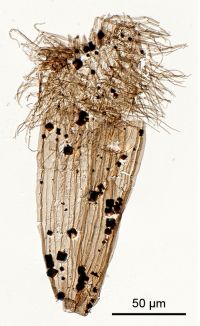Two Selwynites have discovered a new species of fossil that will shed light on early animal ecosystems.
Dr Tom Harvey, a Selwyn alumnus now at Leicester's Department of Geology, together with our Fellow Professor Nick Butterfield, discovered the new species while conducting a survey of microfossils in mudstones from western Canada.
Here Nick sets out four reasons why the discovery matters:
 1) it's the only convincing loriciferan in the fossil record (loriciferans are a phylum of microscopic animals that live between sand grains, only discovered in 1980s), and now we know that they extend all the way back to the Cambrian period (500 million years, surprisingly close to the origin of animals themselves).
1) it's the only convincing loriciferan in the fossil record (loriciferans are a phylum of microscopic animals that live between sand grains, only discovered in 1980s), and now we know that they extend all the way back to the Cambrian period (500 million years, surprisingly close to the origin of animals themselves).
2) it's exquisitely well preserved and surprisingly modern in its construction. Though different from any living forms in detail, there is no question that there is a direct lineage leading from the fossil to modern forms.
3) it's tiny; the adults are less than a third of a millimetre long. This puts it fully in the category of 'meiofauna' which is recognized as a special category in terms of adaptation and behaviour. In terms of the famous 'Cambrian explosion' around 530 million years ago, it demonstrates that animals were madly diversifying in all directions at this time - experimenting with miniaturization as well as all the large and more obvious habits of the conventional fossil record
4) more generally, these 'small carbonaceous fossils' constitute a whole category of (previously overlooked) palaeontological information that is making substantial changes to how we view evolutionary patterns through deep time.
You can read more in the University of Leicester news release here: http://www2.le.ac.uk/offices/press/press-releases/2017/january/chance-discovery-of-new-fossil-from-half-billion-yearsd-ago-sheds-light-on-life-on-earth




